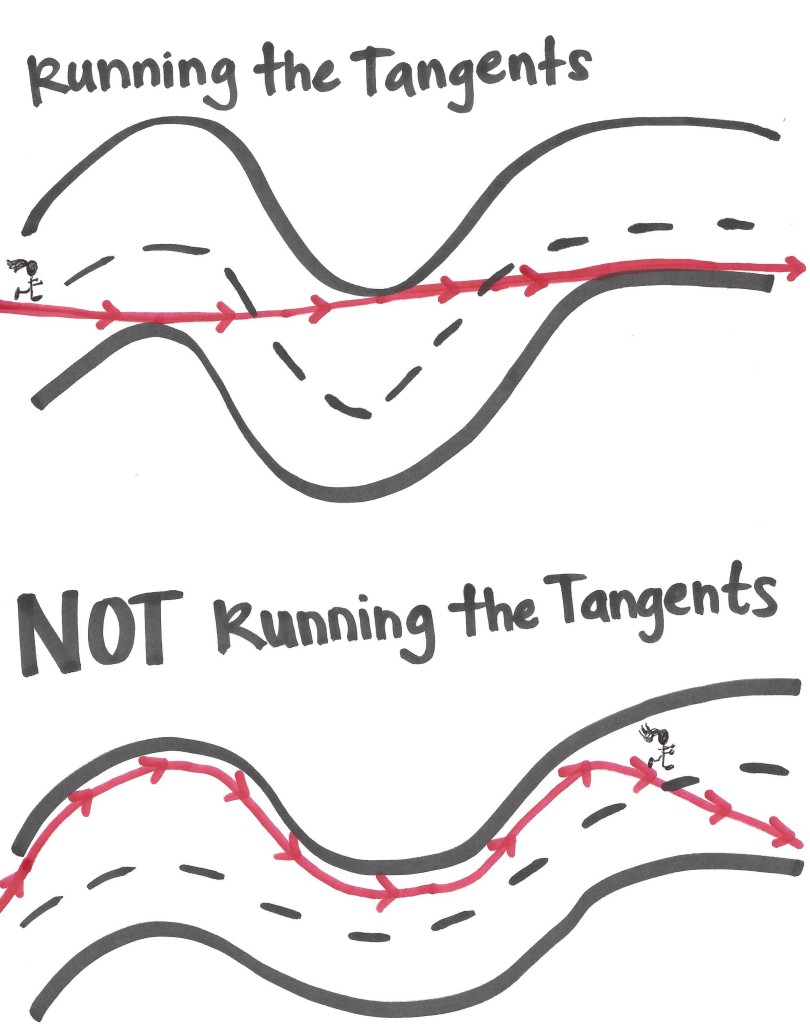Protect Your Next PR: Running the Tangents
13.37. 26.39. 26.7.
These are all numbers I have seen on my Garmin at the end of races – numbers I never want to see again. When we run half marathons and marathons, the last thing we want to do is run more than we have to. Not only does it result in wasted energy when we’re already tired; it results in a slower time on the clock than could have been achieved if we ran the targeted 13.1 or 26.2 miles. It’s also the quickest way to dash the chances of a PR (personal record) or BQ (Boston qualifying time) if you are gunning for a new personal best.
So what causes this? How can we prevent running further than we should during races? The secret is in running the tangents.
Running the tangents simply means running the shortest distance on a race course, which is how the course is measured. Although races often contain many turns and curves, tangents are straight lines. That means in order to run the tangents, you will need to run in a straight line from curve to curve rather than following the middle of the road and snaking around every curve.
Perhaps an explanation in pictures would be easier:

Here are some tips to help you race more efficiently by running the tangents during your next race:
- Familiarize yourself with the race course before race day. Study the curves and turns on the course map and think about where you will need to be in the road to run as straight of a line as possible. If you are running a bigger race where pacers are offered, ask the pace leaders at the expo about their strategy for running tangents. I have run with pacers before that didn’t run the tangents, and I had to leave them because we were starting to run too much added distance.
- Be on the lookout for curves and turns. One of the simplest things you can do to run the tangents is to simply keep your eyes open and be alert. When you conquer one curve, start looking for the next so you can position yourself correctly in the road and maintain straight lines. When you zone out and stop paying attention, it’s easy to miss the tangents.
- Don’t be afraid to get out of line. Many races try to keep runners on one side of the road with cones in the middle off the road. If a road is closed off and/or there is no traffic, do not feel you have to stay within those cones when the race is actually measured in a straight line across the entire road. Look at the drawings above. If you didn’t cross over the line in the middle of the road, you’d be adding extra mileage and turns by snaking along the course in an “S” shape. If you are racing and the road is not closed, you will have to use greater caution if the road is open to traffic and this may not be a possibility. Ask race staff at the expo if there are any rules about this to ensure you are safe. During my recent Kauai Marathon and at the ZOOMA Florida Half Marathon earlier this year, I was one of the only people cutting all the way across the road rather than staying within the cones to run the tangents. Guess what my watch said at the end of both races? 26.2 and 13.1. Bam!
- Consider training to run a slightly faster pace. If you know you will be unable to run all the tangents due to large crowds, open roads with traffic, etc., consider training for a slightly faster pace (a few seconds per mile) to help overcome the added time that will be on the clock from running a slightly longer distance.
- Be respectful of your fellow runners. Be mindful as you run against the crowd from inside curve to inside curve that you aren’t cutting off other runners or plowing into other people. Be respectful to your fellow runners and don’t let your running the tangents cause problems for others.
Running the tangents can take practice, and there is no perfect way to do it. Be mindful of the tangents and just do the best you can to overcome turns and curves.
What other tips do you have for running the tangents and being more efficient on race day? What is the longest distance you’ve ever logged during a race due to not running the tangents?



Comments
This is something new I have just been working on this year. I hate to admit, but I didn’t know about tangents at my first marathon and just hugged the edge of the road, my Garmin read 28somethingMiles at the finish. Ahhhh….
This is really great info!! I really never thought about how the course was measured but it is quite irritating to see that extra bit on the watch. This recently happened at my last 10k and my mileage on the watch said 6.34. It happened to be my best time for that distance but obviously not for the actual 10k. I am going to be reviewing the course map for Savannah for sure. I don’t really want to run any further in the marathon than I have to.
Good tips Jesica! I need to brush up on my skills. It bothers me that I am not going to see the chicago course before that weekend, when we moved, it made it too difficult to get to the half I was going to do. But I do plan to study the course, and yes, make it as short as possible. I am thankful I will be able to do this relatively easily as we are set off before everyone else. Thanks for the advice!
It can make a huge difference, especially for a marathon. Every course is measured on those tangents, so running even slightly off can add up. I say do the best you can but also don’t stress about it too much unless those seconds to minute or so will make all the difference to you. And final word–no complaining to the RD when your garmin measures long, people!
I teach geometry so the word tangent and the diagrams made me smile.
Haha Christy. I’m sure you could have really helped me with my sad little drawings. xo
It always drives me crazy when I look down at my watch and realize that I’ve run much further than the stated distance. Definitely something that I am trying to be more mindful of. PS I love your tangent drawing!
The other thing to remember is that GPS watches get skewed when the course goes in between tall buildings (typical in city-based courses). For example, there is a spot on the Philly half and marathon course where your watch pace will suddenly drop, making it appear that you are running a 6:48 mile when you are really running 8:00 mile pace. Comparing your watch pace for a mile to the actual time between race mile markers is a good practice.
Totally agree with you Tom. Having your real-time pace on your Garmin is not always accurate. I always have mine beep (auto lap) at one mile so I can see the true average pace and how close it beeps to the mile markers. In smaller races it is possible that the mile markers are positioned slightly off, so that is also something to keep in mind. Thanks for your thoughts and advice!
I’ve gotten better about this over the years but, I do tend to ‘zone out’ (or really, to zone IN on the race) and forget about where I should be running. Great examples though and I especially love the professional drawings 🙂
Haha! You didn’t know I was a professional artist did you. Bahahahahaha 🙂 xo
Definitely something I need to get more skilled at! I cannot even tell you how many more miles I’ve run over the years than I’ve needed to!
Great post! I feel like I make a serious effort in every race to run tangents yet my garmin is always showing a longer course! I like the idea of really studying the course in advance!
Love this post! I never think about tangents during a race, and I need to start! I’m going to focus on this for my Nov. 1st 5k.
Such a great article 2 and 4 especially! I try to run the tangent in all races that are closed courses (unfortunately you can’t on an open course). It makes a difference if you keep you head up and try to visualize the tangent and run it. Sometimes you can feel like the loan wolf, especially if ppl around you aren’t running the tangent. You have to be alert and aware and not just follow the runner in front of you.
Great advice Sarah!
I ran a half marathon last weekend and ended up with 13.29 miles….I wasn’t too surprised and didn’t want to overthink the tangents, but YES, if you’re trying to PR it definitely is important to know your route!
Congrats on your race Janelle! I hope you enjoyed your day!
[…] My Garmin displayed 3.2 miles for both races. I noticed I was already at 1.1 miles after I passed the first mile marker. I’ll need to make some slight adjustments and hope I run the tangents (some good articles here and here). […]
[…] runladylike.com Jesica has an excellent post on how to do this correctly! Clearly I need to read it […]
[…] more about running the tangents at http://www.runladylike.com/2014/09/24/running-the-tangents/ If you’re going contact the RD, why not have it be to compliment her on all of […]
[…] a bear: no sudden movements. For a great visual of running tangents, check out this image from Runladylike. If you follow that link, she has some great tips for running the […]